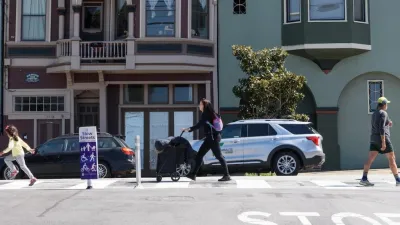A report by Smart Growth America and the National Complete Streets Coalition ranked the danger to pedestrians in metro areas around the country. The report finds the metro areas of the Sun Belt are the least safe to be the least safe places to walk.

Sarah Goodyear shares the brutal statistics of a new report quantifying pedestrian safety in the United States. "Between 2003 and 2012, 47,025 pedestrians were killed by drivers in the United States. To put that in perspective, that’s 16 times the number of fatalities caused in the same period by the natural disasters – floods, tornadoes, hurricanes, and the like – that get so much more attention. An additional 676,000 were injured, the equivalent of one person every eight minutes."
The "Dangerous by Design 2014" [PDF] report by Smart Growth America and the National Complete Streets Coalition used the Pedestrian Danger Index (PDI) to quantify where pedestrians are most likely to get hit by a person driving a car.
As it has in the past, Florida dominates the top of the list, with the Orlando-Kissimmee metro area—the first of four in Florida to top the list, with a PDI of 244.28. The national average was 52.2.
On the flip side, the safest metro area was Boston-Cambridge-Quincy in Massachusetts, with a PDI of 18.65.
While acknowledging the difficulties inherent in changing such ingrained behavior, Florida officials said the right things after the report's release. "We want to change the culture, just as we did with the increased use of seat belts," said Billy Hattaway of the Florida Department of Transportation in a telebriefing on the report.
Alex Davies also reports on the study. In addition to focusing on the 20 metro areas at the top of the list, Davies contrasts the funding for "Transportation Alternatives" in the soon-to-expire MAP-21 transportation bill. The reauthorization bill passed by the Senate Environment and Public Works Committee last week "would provide funding through 2020, but maintain the current formulas for sharing that money." Ergo, "pedestrians would still lose out."
Goodyear also shares news of another relevant piece of federal legislation currently proposed in Congress, the Safe Streets Act of 2014. That bill would "require all states and Metropolitan Planning Organizations (MPO) to adopt complete street policies for federally funded projects within two years, and consider the safety of all users when designing new roads or improving existing roads."
Angie Schmitt also covered the report, identifying a few additional, salient trends worth noting from the report. For instance, in cities that had low PDIs, "walking is not only safer, it’s more widespread. In Boston, 15 percent of residents travel to work on foot. In Pittsburgh it’s 11.3 percent. That’s compared with less than 2 percent in Orlando." As for why that could be: "It’s not just that more people walk because it’s safer. The 'safety in numbers' effect may also help explain what’s going on — walking is safer in places with more pedestrians."
Then there is the type of street that is the biggest danger to pedestrians. Schmitt writes: "Arterial roadways — streets designed to collect traffic from smaller streets — are notoriously hostile to people walking. But they’re also difficult to avoid. A majority of pedestrian fatalities over the last decade — 52 percent — happened on arterial roads."
FULL STORY: The Most Dangerous U.S. Cities for Pedestrians

Alabama: Trump Terminates Settlements for Black Communities Harmed By Raw Sewage
Trump deemed the landmark civil rights agreement “illegal DEI and environmental justice policy.”

Study: Maui’s Plan to Convert Vacation Rentals to Long-Term Housing Could Cause Nearly $1 Billion Economic Loss
The plan would reduce visitor accommodation by 25% resulting in 1,900 jobs lost.

Planetizen Federal Action Tracker
A weekly monitor of how Trump’s orders and actions are impacting planners and planning in America.

Wind Energy on the Rise Despite Federal Policy Reversal
The Trump administration is revoking federal support for renewable energy, but demand for new projects continues unabated.

Passengers Flock to Caltrain After Electrification
The new electric trains are running faster and more reliably, leading to strong ridership growth on the Bay Area rail system.

Texas Churches Rally Behind ‘Yes in God’s Back Yard’ Legislation
Religious leaders want the state to reduce zoning regulations to streamline leasing church-owned land to housing developers.
Urban Design for Planners 1: Software Tools
This six-course series explores essential urban design concepts using open source software and equips planners with the tools they need to participate fully in the urban design process.
Planning for Universal Design
Learn the tools for implementing Universal Design in planning regulations.
Caltrans
Smith Gee Studio
Institute for Housing and Urban Development Studies (IHS)
City of Grandview
Harvard GSD Executive Education
Toledo-Lucas County Plan Commissions
Salt Lake City
NYU Wagner Graduate School of Public Service





























